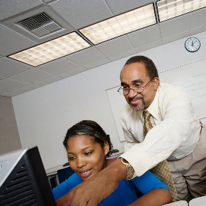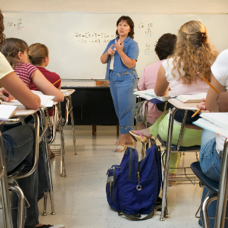By Leslie Scott, MSSA, LSW, CTP-C, Professional Development Coordinator
With the start of a new school year, comes new school supplies, new students, new teachers, and lots of new emotions. Emotions that often express themselves in the classroom. Sometimes this is excitement, joy, and relief. Sometimes this is anger, worry, or loneliness. As a teacher, this alone is a lot to handle, not to mention the lesson plans, paperwork, and other commitments.
By making the classroom a better place for students and teachers, we build positive role models and the foundation of success for every child. So, as you start this school year, here are a couple tips to help your classroom start off right.
KNOW YOUR VALUES

Why did you become a teacher? Was it because of a teacher who impacted your life? Were your parents’ teachers? Did you want to change people’s lives? It’s easy to forget that when someone makes an impact in our lives, they are really teaching us their most important values. Their values then become powerful memories for us. What are your most important values?
If you had to pick one of those values to apply to every activity, lecture, or interaction with students, which value would it be? Take time to focus on active steps you can make this year to instill that value.
KEEP THEM IN THE CLASSROOM
Studies show that when students are out of the classroom for behavioral concerns, they are more likely to become involved in the criminal justice system. Resulting in the “School to Prison Pipeline”.
7 million students were suspended or expelled in the 2011-2012 school year. At highest risk are non-white and disabled students. (US Department of Education, 2016).
Being in the classroom teaches valuable life skills, how to manage emotions, reinforces positive behaviors, and tips for focusing. This helps students stay engaged in learning and builds a healthy relationship between you and the student. You may be the only healthy influence in their life or the only who notices they are struggling. That is a chance for them to get help and start building the coping skills they need for a healthy adulthood.
Having these items available to students can keep homeless or neglect students attending:
- Non-perishable snacks and bottles of water

- Deodorant or Shower Wipes (that don’t use water)
- Toothbrush and toothpaste kits
- Comfy socks
- Plain t-shirts (so they can wear them multiple times without people noticing or bullying them)
- Underwear
INCREASE AWARENESS OF SELF
Small moments of mindfulness can also help keep students engaged. Mindfulness doesn’t have to be quiet, zen-full, or yoga. Mindfulness is about being in the present. Starting your class off, ending your class, or taking a short break to connect with the present, can help students remain in the classroom, but also learn to connect with their body, their needs, and their emotions.
Short mindful moments to try:
- Deep breathing
- Ring a bell – have everyone freeze, focus on their body – do they feel tense? Restless? Stressed? Take some deep breaths, relaxing their body from their feet to their head
- Before the end of class bell rings, think of 1 thing you need to be successful in your next class
- Stretching, standing up, move seats mid-class (if you’re willing to risk it… last person who sits down must clean the classroom)
- Write or say something nice to themselves or someone else
- Snack break – maybe a mint or small piece of chocolate
- Popcorn “get to know you” or “ice breaker” questions
- Play soft music or meditations in the background
- For students with ADD/ADHD or just struggle to remain seated, give them small tasks to complete throughout the class. Physical tasks (even if unnecessary) can be the physical release of energy they need to focus.
Other Coping Skills for the Classroom:
- Rainbow: Find each color of the rainbow, while deep breathing, focus back in on your work or the teacher talking
- Remind yourself where you are and that you are safe
- Take a short bathroom break
- Doodling or note taking
- Talk about alternative choices non judgmentally
- Give yourself a hug while deep breathing (great for trauma)
- Calming jar
- Feelings cube
- Quiet corner with bean bag chairs
- Alternative to lectures – provide books for students to read on the topic
- Write a list of 5 positive things about yourself or your life
- Write a letter to your teacher sharing your worries, concerns, or other feelings
- Schedule a meeting with your school counselor during your lunch time
- Have a jar or place for students to pick a classroom coping skill
Whichever of these coping skills you choose to incorporate in the classroom, it’s important to discuss them in a positive way throughout the year. Students may live in environments where mental health is viewed negatively, or seeking treatment is frowned upon. Talking about coping skills as a positive prevention step, allows students to explore for themselves their beliefs and learn healthy coping.
One of the most effective skills I’ve seen in classrooms, is allowing students open access to a mental health safe space. At any age, when students are given the opportunity to correct their behavior or respond to a need, we are building their self-esteem, awareness, and positive coping. Choose a place in your classroom, maybe close to the door or in the back of the classroom. Keep books, appropriate fidget items, and written ideas for coping skills. Some teachers use mailboxes or a feelings container, where students can write anonymously or to the teacher what they are feeling. Teachers tell me they’ve gotten letters disclosing that students were being bullied, didn’t have enough to eat, or were afraid to raise their hand in class. Students tell me they like being able to write down their negativity, put it in a box, and leave it there. Rather than carrying it with them, thinking about it throughout their day.
If you do not remain the same room all day, carrying or having a feelings box for each room helps you connect to each of your students. The easiest way to create this box, is to buy a small tubberware or storage bin. Put stickers and other creative charms on the outside. Introduce the box to the students. If the box is anonymous, encourage students to rip up their letters before placing them in the box, as a way of taking charge of their emotions.
If you are worried about students reading other’s letters, there are boxes you can purchase with locks. It’s important to talk about what it means for the classroom to be a safe space with students. This helps them take ownership and pride in creating a safe space, rather than being a guest in it.
FIDGET TOYS
Fidget toys are not needed for everyone, but many students find them useful. Students who have traumatic events at home, such as abuse, fighting, or drug use, can use fidget toys to keep them focused on their schoolwork and in the classroom.
Alternatives to typical fidget toys:
- Dry erase boards w/ markers (for doodling, writing answers, or projects)
- Marble sensory fabric sticks
- Tangle toys
- Coiler keychains
- Rubber bands around chair legs
- Large erasers
- Blankets
- Small throw pillows
- Crochet or Knit (maybe donate their projects to homeless adults at the end of the year)
- Designate a note taker each class
TAKE CARE OF YOURSELF
You’ve probably heard the analogy; you can’t help someone put their oxygen mask on if you don’t put yours on first. Don’t wait until you are already burned out. Take moments throughout the day to put yourself first.
Write yourself a self-care plan. Fill it with easy items that you can do throughout your day, such as taking a deep breathing break before entering the classroom or read a book before bed. Remember, for you to show empathy towards others, you must first show empathy to yourself. This includes recognizing and respecting your own emotions, needs, and wants.
BUILD STUDENT SAFETY NETS
Before issues arise in your classroom, ask your school counselor to come introduce themselves, do empathy building activities, or take 5 minutes to tell each student about Huckleberry House and other counseling resources available to them. Try keeping a clipboard with student’s names in your room, where they can write down if they need help or let you know if they had a bad night. Have coping skills and fidget toys ready for students to grab, as they need, rather than asking for them or depending on them to bring them into the classroom.
Did you know that Huckleberry House will come to classrooms to talk about our crisis shelter, counseling, and housing programs? We also offer lots of professional development trainings and can come to your school for PD days.

Have resources ready for them – have a place in your classroom or let your students know that their counselor has resources outside their office for counseling and other needs. Normalize that counseling and mental health disorders are a common struggle for many people. It doesn’t make them crazy or mean something is wrong with them – it’s also not something they have to struggle with for their entire lives, should they choose to get help.
Show patience to students and their parents. Just as with students, parents with disruptive, rude, or disengaged behaviors may also be struggling with getting their basic needs met, struggling with a mental health disorder, or have grown up in a traumatic environment. All these factors have been shown in research to not only impact brain development, but also our behavior, perception of other’s actions, our physical and mental health.
“The parents who require the most patience, are often the children we missed”
– Jaida Green, a Therapist at the Counseling Center
If you’d like Huckleberry House to come speak to your students, please contact our Youth Outreach Specialist, Jasmine Ayres, at (614) 826-3630.
If you’re interested in a training by Huckleberry House, please contact us at profdev@huck-house.org or by phone (614) 294-8097.
24/7/365 Huckleberry House Crisis Line @ (614) 294-5553
Resources
US Department of Education. (2016, July 18). School Climate and Discipline: Know the Data. Retrieved from https://www2.ed.gov/policy/gen/guid/school-discipline/data.html



